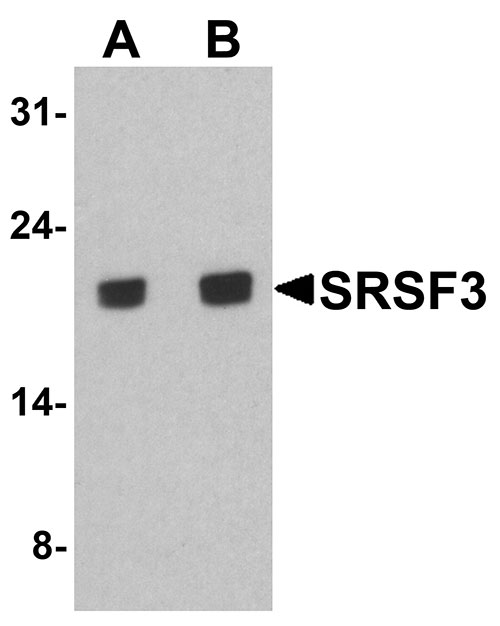SRSF3 Antibody
- 产品详情
- 实验流程
- 背景知识
Application
| WB, E |
|---|---|
| Primary Accession | P84103 |
| Other Accession | NP_003008, 4506901 |
| Reactivity | Human, Mouse, Rat |
| Host | Rabbit |
| Clonality | Polyclonal |
| Isotype | IgG |
| Calculated MW | 19330 Da |
| Concentration (mg/ml) | 1 mg/mL |
| Conjugate | Unconjugated |
| Application Notes | SRSF3 antibody can be used for detection of SRSF3 by Western blot at 1 - 2 µg/ml. |
| Gene ID | 6428 |
|---|---|
| Other Names | Serine/arginine-rich splicing factor 3, Pre-mRNA-splicing factor SRP20, Splicing factor, arginine/serine-rich 3, SRSF3, SFRS3, SRP20 |
| Target/Specificity | SRSF3; SRSF3 antibody is human, mouse and rat reactive. |
| Reconstitution & Storage | SRSF3 antibody can be stored at 4℃ for three months and -20℃, stable for up to one year. |
| Precautions | SRSF3 Antibody is for research use only and not for use in diagnostic or therapeutic procedures. |
| Name | SRSF3 |
|---|---|
| Synonyms | SFRS3, SRP20 |
| Function | Splicing factor, which binds the consensus motif 5'- C[ACU][AU]C[ACU][AC]C-3' within pre-mRNA and promotes specific exons inclusion during alternative splicing (PubMed:17036044, PubMed:26876937, PubMed:32440474). Interaction with YTHDC1, a RNA- binding protein that recognizes and binds N6-methyladenosine (m6A)- containing RNAs, promotes recruitment of SRSF3 to its mRNA-binding elements adjacent to m6A sites within exons (PubMed:26876937). Also functions as an adapter involved in mRNA nuclear export (PubMed:11336712, PubMed:18364396, PubMed:28984244). Binds mRNA which is thought to be transferred to the NXF1-NXT1 heterodimer for export (TAP/NXF1 pathway); enhances NXF1-NXT1 RNA-binding activity (PubMed:11336712, PubMed:18364396). Involved in nuclear export of m6A- containing mRNAs via interaction with YTHDC1: interaction with YTHDC1 facilitates m6A-containing mRNA-binding to both SRSF3 and NXF1, promoting mRNA nuclear export (PubMed:28984244). |
| Cellular Location | Nucleus. Nucleus speckle. Cytoplasm. Note=Recruited to nuclear speckles following interaction with YTHDC1. |
For Research Use Only. Not For Use In Diagnostic Procedures.
Provided below are standard protocols that you may find useful for product applications.
BACKGROUND
SRSF3, a member of the serine/arginine (SR)-rich family of pre-mRNA splicing factors which constitute part of the spliceosome, may be involved in RNA processing in relation with cellular proliferation and/or maturation (1,2). Each of these factors contains an RNA recognition motif (RRM) for binding RNA and an RS domain for binding other proteins (3). The RS domain is rich in serine and arginine residues and facilitates interaction between different SR splicing factors. In addition to being critical for mRNA splicing, the SR proteins have also been shown to be involved in mRNA export from the nucleus and in translation (3,4).
REFERENCES
Sen S, Jumaa H, and Webster NJ. Splicing factor SRSF3 is crucial for hepatocyte differentiation and metabolic function. Nat. Commun. 2013; 4:1336.
Gonçalves V, Matos P, and Jordan P. The beta-catenin/TCF4 pathway modifies alternative splicing through modulation of SRp20 expression. RNA 2008; 14:2538-49.
Tang Y, Horikawa I, Ajiro M, et al. Downregulation of splicing factor SRSF3 induces p53β, an alternatively spliced isoform of p53 that promotes cellular senescence. Oncogene 2013; 32:2792-8.
Jia R, Li C, McCoy JP, et al. SRp20 is a proto-oncogene critical for cell proliferation and tumor induction and maintenance. Int. J. Biol. Sci. 2010; 6:806-26.
终于等到您。ABCEPTA(百远生物)抗体产品。
点击下方“我要评价 ”按钮提交您的反馈信息,您的反馈和评价是我们最宝贵的财富之一,
我们将在1-3个工作日内处理您的反馈信息。
如有疑问,联系:0512-88856768 tech-china@abcepta.com.























 癌症的基本特征包括细胞增殖、血管生成、迁移、凋亡逃避机制和细胞永生等。找到癌症发生过程中这些通路的关键标记物和对应的抗体用于检测至关重要。
癌症的基本特征包括细胞增殖、血管生成、迁移、凋亡逃避机制和细胞永生等。找到癌症发生过程中这些通路的关键标记物和对应的抗体用于检测至关重要。 为您推荐一个泛素化位点预测神器——泛素化分析工具,可以为您的蛋白的泛素化位点作出预测和评分。
为您推荐一个泛素化位点预测神器——泛素化分析工具,可以为您的蛋白的泛素化位点作出预测和评分。 细胞自噬受体图形绘图工具为你的蛋白的细胞受体结合位点作出预测和评分,识别结合到自噬通路中的蛋白是非常重要的,便于让我们理解自噬在正常生理、病理过程中的作用,如发育、细胞分化、神经退化性疾病、压力条件下、感染和癌症。
细胞自噬受体图形绘图工具为你的蛋白的细胞受体结合位点作出预测和评分,识别结合到自噬通路中的蛋白是非常重要的,便于让我们理解自噬在正常生理、病理过程中的作用,如发育、细胞分化、神经退化性疾病、压力条件下、感染和癌症。






